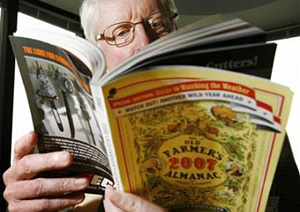 |
 |
 |
 Editorials | Environmental | September 2006 Editorials | Environmental | September 2006  
Old Farmer's Almanac Sees Harsh US Winter
 Jason Szep - Reuters Jason Szep - Reuters


| | Editor-in-chief Judson Hale looks at a copy of the 2007 edition of the Old Farmer's Almanac following an interview in Boston, Massachusetts September 13, 2006. (Brian Snyder/Reuters) |
The Old Farmer's Almanac is embracing new technology - from Internet podcasts to a 24-hour Web cam - as the 215-year-old Yankee oracle warns of a harsh North American winter with a chance of snow even in Las Vegas.

North America's oldest continuously published periodical, a compendium of curious articles, zodiac secrets, humorous anecdotes and weather forecasts, says winter temperatures will be as much as 8 degrees F below its 30-year average.

"But there will be less snow than average on the northern plains, which is an usual place to have less snow," Judson Hale, the almanac's 73-year-old editor-in-chief, told Reuters in an interview on Wednesday.

He said sales and profit margins of the yellow-jacketed periodical were stronger than ever with an estimated 8 million readers - only about 9 percent of whom are farmers.

Most are women and many are gardeners. In Clovis, New Mexico, 68-year-old Billie Whitfield uses it to plan her gardening, while Joe Billicki in Massachusetts swears by its trove of tidal charts and astronomical forecasts.

"I buy it to see what days the full moons are and the tides and the little stories they have in there, and for the weather forecasts," said Billicki, 56, who has saved every issue since 1977 in a bookshelf in his Wakefield, Massachusetts home.

But faced with ever-expanding sources of rival weather news - from 24-hour cable television to the Internet and satellite radio - the almanac is embracing new technology to broaden its audience and maintain its recipe for longevity.

It now offers its own podcast, allowing Internet users to download audio clips, to complement the 256-page tome, which still has a hole in the upper left-hand corner so it can be easily strung and nailed to the kitchen or outhouse wall.

A Web cam provides a 24-hour glimpse of its office in a quaint, red New England cape in the lakeside village of Dublin, New Hampshire where it continues to spin out folksy wisdom in articles like "Carving cues from a Pumpkin pro."

FOLKLORE?

Among its illuminations for 2007: It may snow in Kentucky and Tennessee this winter. You can tell how aggressive a man is by the size of his index finger. People with red hair feel more pain than brunettes. And lip balm can help you whistle better.

"We attempt to be useful with a pleasant degree of humor," said Hale who, like the almanac itself, has an easy, irreverent manner as he thumbs through its pages. "If you think it is totally for fun, you're missing the point, and if you think it's totally serious, you're missing the point."

The little magazine - not to be confused with the Farmers' Almanac published in neighboring Maine - claims to get the weather right about 80 percent of the time, though it failed to forecast last year's unusually warm January.

"We didn't do as well last year - overall we were down to 63 percent. We would have been much much better if you didn't count the temperature foul up in January," he said.

Though weather fanatics rely on its secret formula of solar activity, climatology and meteorological data for weather forecasts, it also gets its share of skeptics.

Steven Babin, senior meteorologist at Johns Hopkins University in Baltimore, dismisses it as a quaint book with little grounding in meteorology. "It's a bit like tossing a coin," he said.

Jan Null, who worked at the National Weather Service for 23 years in California, studied the almanac's forecasts for 2001, 2003 and 2005 and concludes they were right about 25 percent of the time. "I am just not convinced that we have the tools to make good long-range forecasts," he said. | 
 | |
 |



